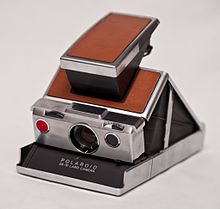
Back كاميرا فورية Arabic তাৎক্ষণিক আলোকচিত্রগ্রহণযন্ত্র Bengali/Bangla Càmera instantània Catalan Instantní fotoaparát Czech Camera sydyn Welsh Sofortbildkamera German Cámara instantánea Spanish Pikakamera Finnish Appareil photographique instantané French מצלמת פיתוח מיידי HE




An instant camera is a camera which uses self-developing film to create a chemically developed print shortly after taking the picture. Polaroid Corporation pioneered (and patented) consumer-friendly instant cameras and film, and were followed by various other manufacturers.
The base of the technology is from a Hungarian chemist, Rott Andor. His invention, direct positive photography, also known as DTR (Diffusion Transfer Reversal) was patented in 1939. With the DTR process, the photographed surface or object immediately appears as a positive, which is an image corresponding to the dark and light shades of the original. When developing the image, the fixer and the developing material are present at the same time, and they immediately interact.
The invention of commercially viable instant cameras which were easy to use is generally credited to American scientist Edwin Land, who unveiled the first commercial instant camera, the model 95 Land Camera, in 1948,[1] a year after he unveiled instant film in New York City.
In February 2008, Polaroid filed for Chapter 11 bankruptcy protection for the second time and announced it would discontinue production of its instant films and cameras, shut down three manufacturing facilities, and lay off 450 workers.[2] Sales of analog film by all makers dropped by at least 25% per year in the first decade of the 21st century. In 2009, Polaroid was acquired by PLR IP Holdings LLC, which uses the Polaroid brand to market various products often relating to instant cameras. Among the products it markets are a Polaroid branded Fuji Instax instant camera, and various digital cameras and portable printers.
As of 2017[update], film continues to be made by Polaroid B.V. (previously the Impossible Project) for several models of Polaroid camera, and for the 8×10 inch format.[3] Other brands such as Lomography, Leica, Fujifilm, and others have designed new models and features in their own takes on instant cameras.
- ^ "Polaroid Wins Patent Suit Against Kodak". Mass Humanities. Archived from the original on 2019-02-04. Retrieved 2019-09-13.
- ^ Graham, David (April 3, 2008). "Developing into a thing of the past". Toronto Star. Archived from the original on March 9, 2011. Retrieved September 1, 2017.
- ^ "Home". us.polaroid.com. Archived from the original on 2022-06-25. Retrieved 2022-06-24.